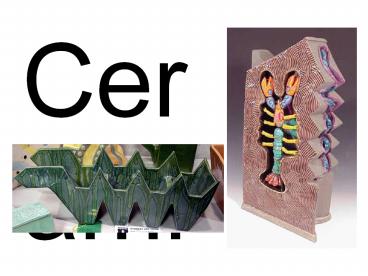Ceramics - PowerPoint PPT Presentation
1 / 11
Title:
Ceramics
Description:
Ceramics Ceramics - Pottery or hollow clay sculpture fired at high temperatures in a kiln or oven to make them harder and stronger. Types include earthenware ... – PowerPoint PPT presentation
Number of Views:112
Avg rating:3.0/5.0
Title: Ceramics
1
Ceramics
2
Ceramics - Pottery or hollow clay sculpture fired
at high temperatures in a kiln or oven to make
them harder and stronger. Types include
earthenware, porcelain, stoneware, and terra
cotta.
Clay - Mud moist, sticky dirt. In ceramics, clay
is the basic material, usually referring to any
of a certain variety of mixtures of such
ingredients -- fine-grained, firm earthy material
that is plastic when wet, brittle when dry, and
very hard when heated.
Earthenware - pottery or other objects made from
fired clay which is porous and permeable.
Earthenware is fired at relatively low
temperature, may be glazed or unglazed, and is
usually but not always buff, red, or brown in
color.
Bisque - Clay that has been fired once but not
glazed.
Greenware - Generally refers to unfired pottery.
leather-hard - In ceramics, a state in which clay
has lost moisture to evaporation, but has not yet
completely hardened clay damp enough to be
joined to other pieces with scoring and slip.
slip - An creamy liquid made by mixing finely
ground clay with water. It is also used in the
making of pottery to cement together parts that
have been formed separately.
3
scoring - To make scratches or creases in pieces
of clay to be joined together. Scoring and
applying slip to such roughened surfaces creates
a bond that holds the pieces together.
coil and coil method or coil construction - Coils
are long, snake-like ropes of clay that are used
in making pottery. The coil method of making
pottery involves building the walls of a pot with
a series of coils into the required shape. Once
the desired height has been reached the surface
can either remain coil-textured or they can be
smoothed. Much pottery in primitive cultures was
made this way, and remains one of the principle
hand-building technique potters use.
pinch, pinch-pot - Pinching is a pottery
technique, making a pinch-pot is pressing the
thumb into a ball of clay, and drawing the clay
out into a pot by repeatedly squeezing the clay
between the thumb and fingers.
slab construction - A pottery technique in which
a form is built up by joining shapes cut from
thick sheets of damp clay.
throwing - In pottery, throwing means making a
pot from a piece of clay on a potters wheel.
potter's wheel - A revolving horizontal disk, on
which clay is shaped manually into pottery
vessels.
pottery - Objects, and especially pots, which are
made from fired clay. Pots are functional ceramic
objects, and may take such forms as plates,
bowls, cups, jars, vases, urns, ewers (pitchers),
bottles, and boxes.
4
glaze - A term used in ceramics to describe a
thin coating of minerals which produces a glassy
transparent or colored coating on bisque ware.
Typically applied either by brushing, dipping, or
spraying, it is fixed by firing the bisque ware
in a kiln. This makes the surface smooth, shiny,
and waterproof.
glossy - Surfaces which are shiny.
matte - Having a dull, flat, non-reflective,
sometimes roughly textured finish.
firing - A process of applying heat to make hard
pottery in either an oven or an ovenlike
enclosure called a kiln. Also the means of fixing
colors to ceramic surfaces.
kiln - An special oven or furnace that can reach
very high temperatures and is used to bake, or
fire clay. Kilns may be electric, gas, or
wood-fired.
firing cracks - Cracks appearing in a cooling
material, caused by the tension from the
different rates of its shrinking.
5
Types of Clay Sculptures
Coil Construction
6
Pinch Construction
7
Slab Construction
8
More Slabs
9
(No Transcript)
10
Thrown Sculpture
11
More Thrown































